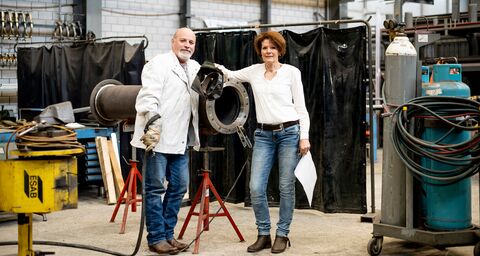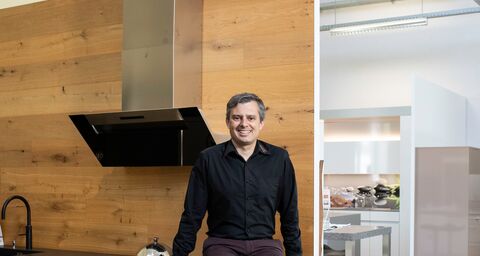
Talent management: attract, develop and retain dedicated people
Relax in the face of a shortage of skilled workers? Unfortunately this is not an option for many SMEs. We show you what active talent management offers and what options you have.
The latest AXA SME labor market study shows that employee demands are presenting SMEs with increasing challenges. Many entrepreneurs ask themselves: “What can I do to make the right people want to work in my company – and stay?”
What is talent management?
Talent management encompasses all the measures that companies take to attract, develop and retain employees with high potential.
However, the approach of specifically targeting special “talents” is sometimes controversial among HR specialists, as Susanne Ziörjen explains. She is a product manager for HR development at AXA and believes: “For many companies, the original meaning of talent management is no longer up-to-date.” Rather than just focusing on specific groups of people, it’s more about finding generally committed employees who want to work together on the company’s purpose.
Talent management as a response to skills shortages
Entrepreneur Cornel Müller advises his customers to engage consciously with different target groups and to respond concretely to their needs. Future of Work Group AG offers both job seekers and companies digital platforms and tools in the area of recruitment and has a lofty vision: Making it easier to bring employers and employees together.
“Due to demographic trends, we will have a shortage of skilled workers in Switzerland in the medium and long term, so it will be important for employers as well as for the economy as a whole to equip employees with the skills they need to prepare them for the job market of the future.” However, “SMEs in particular have limited resources in HR to provide their employees with valuable support in this transformation.”
“The good news is: Targeted measures from the talent management toolbox are also worthwhile for SMEs – and do not necessarily have to be expensive,” explains Susanne Ziörjen.
The main benefits of talent management at a glance
- More satisfied and motivated employees
- Fewer absences and higher productivity
- More diverse workforce and larger pool of potential employees
- Easier internal filling of vacancies
- Greater employer attractiveness and more successful recruiting
Talent management: SMEs should focus on these 6 factors
“As a company, I always have two levers: I can invest in the framework conditions so that employees can reach their full potential. And I can invest directly in their further development,” says Susanne Ziörjen.
In theory, there are numerous measures that companies can take along the entire employee cycle: from recruiting to induction and further development to succession planning and the exit interview.
But it’s also clear: Time and money are limited – especially in SMEs. For this reason, the expert recommends focusing on the areas where you can achieve a great deal even without a large HR department and budget:
1. The frequently quoted “Purpose”
“Employees are more motivated at work if they see meaning in their work and know they are making an important contribution.” Susanne Ziörjen stresses that working together towards a goal creates a sense of togetherness that has proven to have a positive impact on employee productivity.
Our recommendation for action: If you haven’t already done so, put your own values and visions on paper. Then communicate them consistently both internally and externally, for example at internal meetings and workshops as well as in job advertisements.
2. Everyday needs and participation of employees
It is often the small things in day-to-day business that have a decisive impact on employee satisfaction and health. Not to be underestimated either: “Employees are happier at work if they feel their concerns are being heard,” says Susanne Ziörjen.
Our recommendation for action: Find the pulse of your employees regularly and find out their needs: in personal discussions, feedback rounds in small groups or even employee surveys. Invite your employees to play an active role: Instead of simply giving work instructions, you can ask your employees, for example, how they would address a particular problem.
3. Different work models
Flexibility in terms of working from home, working hours and full or part-time work is not only increasingly demanded by employees, but is also paying off for companies. If work and family as well as free time are more compatible, existing employees are happier and healthier. This not only increases motivation and productivity in the workplace, but also reduces staff turnover.
In addition, this increases the number of potential applicants, which leads to greater diversity and thus also different perspectives and ideas in the company.
Our recommendation for action: Consider whether and which (further) flexible working time models could make sense and be implemented in your company and, if necessary, try them out on a trial basis with certain individuals or teams.
4. Incentives other than pay
Let’s face it. When it comes to choosing an employer, salary is and will remain an important incentive for many people. If you don’t have much room for maneuver there, there are other ways to make yourself attractive as an employer.
One option is fringe benefits, such as participation in public transportation passes, REKA-Checks, employee discounts, additional vacation days or attractive pension solutions.
Our recommendation for action: Use low-threshold offers and platforms for employee benefits and seek advice on options for pension funds.
5. Further development and prospects
“In addition to good framework conditions and meaningful work, it is important for dedicated employees to be shown perspectives for further development and to be supported on their learning journey,” stresses Susanne Ziörjen.
But she also says that this doesn’t always have to mean expensive training courses with employees absent from work: “Further development, namely on the job training, is also more practical and cheaper.”
The company benefits in several ways: “Employees develop additional competencies and are more committed. It also makes it easier and faster for them to catch up on vacancies – keyword: internal mobility.”
Duss Küchen AG has also discovered this adjustment in the fight against the shortage of skilled workers. “A lack of skilled staff has been an issue in our industry for some time. We therefore always plan for future departures due to retirement two years in advance so that we can fill the vacancy in good time; we always try to compensate for specific resource constraints with internal reshuffling or to promote apprentices.”
For this reason, kitchen specialists generally focus on the training and development of talented people and always train four to five apprentices at the same time. “We invest a lot in promoting and strengthening the individual abilities and talents of our employees,” explains Managing Director and Board Member René Widmer.
On the one hand, this corresponds to the company’s corporate values, but it is also fundamental to positioning itself as an attractive employer on the job market: “In addition to an interesting job, a modern infrastructure and an independent way of working, these days young talents also seek out flexible work models and the opportunity to grow and train in house.”
Our recommendation for action: You – or your managers – should hold regular discussions to find out what your employees want to learn and achieve next. Let them gain specific experience in these areas, for example by deputizing for staff on vacation or through specific tasks and projects.
If necessary, provide dedicated employees with a mentor so that they can develop even more effectively through regular feedback and exchange.
6. Recruiting
In the area of recruiting, there are also a number of factors that SMEs can use to attract and retain new talent. You can find specific tips on this in our blog article on staff recruitment. But the most important thing is to clearly define which groups of people you want to target, and above all: “Proactively communicate to these people what your company has to offer,” says our HR development expert.
Our recommendation for action: Use your website and any company profiles on social media not only to communicate the purpose of your company to the outside world, but also to present the benefits and opportunities for employees. Be sure to write the text of your job advertisements in appealing, target-group appropriate language.
Conclusion
Small and medium-sized companies without a major HR department and resources can also use targeted measures to increase the productivity, satisfaction and competence of their employees. This makes them more attractive as an employer and makes it easier for them to attract new talent. In the best case, this even triggers an upward spiral, because as we all know: Satisfied employees are the best advertisement for your company.










